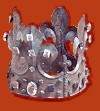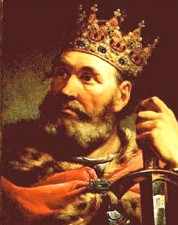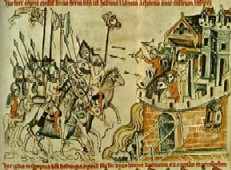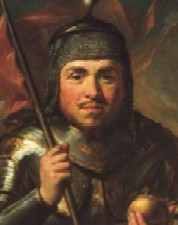Part 1
Below you will find a brief outline of Poland’s history. The dates and events described herein represent, in our opinion, the turning points in Polish history. While short and hardly complete, this outline will provide some insight and might help you get a fuller understanding of the Polish culture and traditions, shaped by the centuries of glory interlaced with the decades of pain and suffering. For a more comprehensive view of Poland’s past we recommend „God’s Playground”, a history of Poland by Prof. Norman Davies.
INTRODUCTION

While Poles trace their roots to prehistoric times, as a nation, present-day Poland dates its real origins to the year 966, when the foundation of Polish statehood was laid. That was the year when Mieszko I, the first historical representative of the old Polish Piast dynasty, accepted Christianity from the south. He is the first member of the gallery of Polish Kings in spite of the fact that only his son, Boleslaw Chrobry – Boleslaw the Brave – was the first ruler to be actually crowned.

In Poland’s lengthy and tumultuous history, its Golden Age, which flourished under the last two kings of the Jagiellonian dynasty, deserves special attention. This was a time rich in art, poetry, religious experience, scientific advances and economic prosperity. It inspired astronomer Nicholas Copernicus to assign Earth a new place in the solar system and moved Wit Stwosz to create his unsurpassed altarpiece, which can still be admired in Krakow’s St. Mary’s Church to this very day. In Krakow, the Royal Castle on Wawel Hill was converted into a splendid Renaissance residence, while a handsome fortress city went up in Zamosc.
Between 1795 and 1918, Poland disappeared from Europe’s maps, to re-emerge once more independent and proud at the end of World War I. The Nazi conquest of 1939, another war and four decades of Communist rule could not vanquish the indomitable and tenacious Polish spirit.
THE ORIGINS
ACCEPTANCE OF CHRISTIANITY – 966
The true origins of Poland have been lost in the mists of time, but a number of popular legends tell of the country’s beginnings. Among them is the tale of three brothers, Lech, Czech and Rus, each of whom set in a different direction to make his own way in the world. Lech went to the west. As he came to a clearing in a forest, he noticed a nest of a white eagle. Lech decided to settle there with his people. He named the place Gniezno (nest) while his people became known as Polanie, which means „field dwellers”.

The eagle became a symbol of his tribe. To this day a white eagle against a red background is the official emblem of Poland. In the beginning of the 10th century the borders of the Holy Roman Empire reached the Odra river . Here the Empire’s eastward colonization encountered a powerful obstacle, the well organized state of Polanie who, unknown to Christian Europe, had been developing an autonomous Slavic culture for about 200 years. For several generations the Polanie, under the leadership of the Piast dynasty, withstood armies of the Empire. Rather than succumb to the Empire’s eastward expansion, in 966 prince Mieszko accepted Christianity from the Czech royal court and married a Czech princess, Dobrawa. This act had tremendous political consequences. Succeeding generations of Poles recognized this date as the birth of Poland. Once liberated from the darkness of paganism, Poland officially appeared on the map of Christian Europe.
THE BIRTH OF A KINGDOM
CORONATION OF BOLESLAW THE BRAVE – 1025
In 997 Brother Adalbert, sent by Mieszko’s son and successor Boleslaw the Brave

to convert the pagan Prussian tribe, was murdered by the Prussians in a place near present day city of Gdansk. According to a legend, Prince Boleslaw purchased the martyr’s body for its weight in gold and brought it back to Gniezno for burial. Upon Adalbert’s subsequent canonization, his grave became a holy site. In the year 1000, Holy Roman Emperor Otto III made a pilgrimage to Gniezno. In his presence, a Gniezno archdiocese was established, responsible directly to Rome and not to the German archbishops across the Odra River. Otto also proclaimed Boleslaw as „a brother and aide in the Empire”, implying no subordinate relationship. Unfortunately, Otto’s ideal of peaceful eastern borders of the Empire came to an end with his premature death. Facing the encroachments of German feudal lords and the new German Emperor on Poland’s western frontiers, Boleslaw attempted to unite the Poles, Czechs, and Slovaks into one large state to meet the threat to the western Slavic tribes. However, the Czech and Slovak lands came only briefly under his rule. Boleslaw also warred in the east, and managed to assist in installing a friendly ruler in Kievan Rus. It is said that the great coronation sword of the Polish kings, Szczerbiec („notched sword”), was then given its name. To attest to his victory, Boleslaw repeatedly struck his sword against the bars of the Golden Gate of Kiev.
Throughout his life, Boleslaw implored Rome for a royal crown. In 1025, near the end of his life, Boleslaw was crowned King of Poland, with the Pope’s blessing but without the German Emperor’s approval. This was an important step towards the recognition of Poland as a true kingdom within Latin Christendom.
REGIONAL DIVISION
BATTLE OF LEGNICA – 1241

After the death of Boleslaw the Brave, Poland faced a time of chaos, despite the occasional energetic leaders like the controversial Boleslaw II the Bold (ruled 1058-1079), and Boleslaw III the Wrymouthed (ruled 1102-1138), renowned for fighting off German invasions and injecting strong leadership into national life. In a development characteristic of feudalism, the earlier stronger monarchy disintegrated into a number of regional states, ruled by local Piast princes. During this period, the city of Cracow became increasingly important, and possession of that city was deemed necessary for assuming rule over the whole country. Another possible center for the reunification of Poland was the region of Silesia, under their local Piast branch. Unfortunately, Henry II the Pious (ruled 1238-1241) died with virtually all of his knights at the fateful baffle of Legnica facing the Mongol (Tartar) incursion into Europe. Virtually all of Poland was savagely devastated, and the Ruthenian principalities fell under Tartar bondage.
This period also saw one of the most fateful events in Polish history in 1226, when a regional Prince, Conrad of Masovia, invited the German Crusading Order of Teutonic Knights to Poland. He gave them a small area in the north-east in exchange for protection from raids by pagan Prussians. By 1288, the Teutonic Knights had conquered the Prussians and had installed themselves in the area, posing a permanent threat to all of Poland.
REUNIFIED KINGDOM – 1320

The regional fragmentation of Poland could not have gone on much longer without severe detriment to the country as a whole. Faced by powerful enemies from many sides, king Wladyslaw Lokietek (the Elbow-High), through an incredible effort and persistence, managed to bring the core of the state together with Krakow as its new capital. The cost of this success was loss of Silesia and Pomerania, which had slipped from Polish rule.
Lokietek’s major achievement was undoubtedly obtaining the Pope’s approval for his appointment as monarch of the reunited realm. Lokietek received the full royal title of Rex Poloniae, with the kingdom named Corona Regni Poloniae, a concept that would achieve a rich tradition and judicial history.
Lokietek’s second greatest achievement was the direction of Teutonic conquest. With the support of the German Empire and the Papacy, the Teutonic Order had conquered lands from Gdansk (renamed Danzig), all the way to the northern country of Estonia. When their attention turned to the south, Lokietek’s forces dealt them a defeat in the Battle of Plowce in 1331, bringing the conflict to a standstill. The Teutonic Knights then menaced Lithuania, one of the last pagan countries in Europe and, in defense, Lithuanians turned to the east, bringing virtually all of present day Belarus and Ukraine into the Polish sphere of influence.
Jak odróżnić legalne kasyno od nielegalnego? Wydawałoby się to proste, ale wciąż wielu graczy w Polsce ma z tym problem. Legalne kasyna na pieniądze muszą posiadać zezwolenie na prowadzenie działalności online. Odpowiednie zezwolenia wydają komisje hazardowe różnych państw, na przykład Wielkiej Brytanii czy Malty. Informacja o uzyskanej licencji powinna być podana na dole strony głównej w widocznym miejscu. Jakie są plusy korzystania z licencjonowanego kasyna Rolling Slots i innych legalnych kasyn online jak Goodman Casino? Taki serwis dba o bezpieczeństwo graczy i ich depozyty. Oferuje również najlepsze bonusy powitalne z niskim wagerem, cashbacki (zwroty gotówki) i bonusy bez depozytu. Legalne kasyno online korzysta również zawsze z licencjonowanego oprogramowania. Najlepsze automaty w rodzaju Hot Chance i inne gry hazardowe pochodzą w takich kasynach wyłącznie z legalnych źródeł, w wyniku podpisania umów z dostawcami. Co najważniejsze, w legalnym kasynie zawsze będziemy mogli wypłacić szybko wygraną i nasze pieniądze są tam bezpieczne.